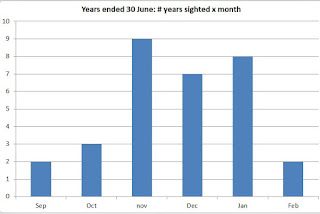The male and female are very different in appearance. The male is yet another boldly black and white bird, with the white in the wings very obvious.
The female is a basic brown bird. I often have trouble identifying them and arrive at the ID only by ruling out all other possibilities (Pipits, Songlarks etc).
This year, more than any other I can recall, the birds have been very vocal around our block. They have certainly lived up to the Triller name.
Getting down to the data, here are two graphs covering reporting rates for the whole COG area of interest.
The upper graph shows the birds arrive in October and stop being recorded in February. I suspect that this may reflect in part them becoming quieter once breeding has been completed. The lower chart reflects the boom or bust abundance of the species. I suspect the very high peak in the late '80s is a boom year coinciding with extra observer effort around the Atlas of ACT birds.
The patterns are similar for our local observations. First the monthly records, with a possible maximum of 11 years.
We have a couple of early records which is, I suspect, merely happenstance. The fact that our recording rate jumps in November rather than October is yet another example of the impact of altitude. We are about 200m higher than the main part of Canberra so seasonal effects tend to be a couple of weeks later here.
Now the annual data which is shown for a year ended June to avoid splitting the migration seasons.
It is unfortunate that the COG series ends in 2013 but where comparison is possible the pattern is broadly similar in the two series.
I wondered about the extent to which rainfall might explain (or at least correlate with) the variation in reporting rate in the local series. That is shown here.
The correlation coefficient between the two series is -0.62 suggesting that the reporting rate is high when rainfall is low.
As most the rainfall in a year ended June occurs after the birds have arrived here that is a tad hard to rationalise. I wondered what the correlation was for the months July- September: the answer is -0.15, a much lower and insignificant value. Could the rainfall in one year affect the reporting rate in the following year? Nice try, no cigar - the correlation coefficient for that is -0.04, effectively zero! Where I get to is some sort of theory that a long-term weather pattern sets up and leads to
- the Trillers coming here; and
- a dry period for several months.
If anyone wants to borrow that idea as the basis of a dissertation, feel free to do so.






No comments:
Post a Comment
I am very happy to receive constructive comments. However anything I deem offensive will not be published.